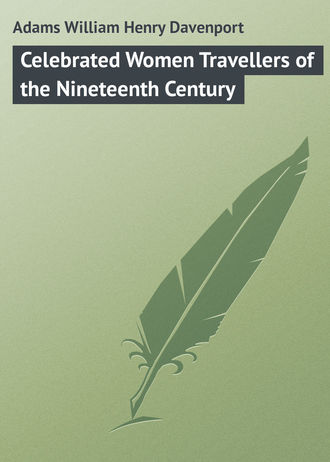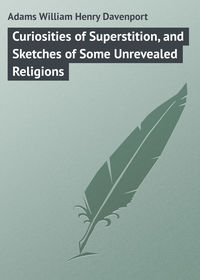 полная версия
полная версияCelebrated Women Travellers of the Nineteenth Century
A few days later, the travellers, having started at two in the morning, passed into a sublime mountain valley, which the waters of a copious stream had cleft through the solid rock. A narrow stony path followed the upward course of the stream. The moon shone unclouded, or it would have been difficult even for the well-trained horses of the caravan to have kept their footing along the perilous way, encumbered as it was with fallen masses of rock.
Like chamois, however, they scrambled up the steep mountain side, and safely carried their riders round frightful promontories and past dangerous and dizzy precipices. So wildly romantic was the scene, with its shifting lights and shadows, its sudden bursts of silvery radiance where the valley lay open to the moon, and its depths of darkness in many a sinuous recess, that even Madame Pfeiffer's rude companions felt the influence of its strange beauty; and, as they rode along, not a sound was heard but the clatter of the horses' hoofs, and the fall of rolling stones into the chasm below. But all at once thick clouds veiled the moon, and so intense a darkness prevailed that the travellers could scarcely discern each one his fellow. The leader continually struck fire with a flint that the sparks might give his companions some indication of the course. This, however, proved insufficient guidance; and at last, as the horses began to miss their footing, their sole chance of safety consisted in standing still. At daybreak, however, a grey light spread over the scene, and the travellers found themselves surrounded by a ring of lofty mountains, rising one above the other in grand gradation, and superbly dominated by one mighty, snow-crowned, massive summit.
The journey was resumed. Soon the travellers became aware of the fact that the path was sprinkled with spots of blood. At last they came to a place where crimsoned a complete pool; and looking down into the ravine, they could see two human bodies, one about a hundred feet below them, the other, which had rolled farther, half hidden by a projecting crag. They were glad to leave behind them this wild Aceldama.
At a town called Ravandus, Madame Pfeiffer had numerous opportunities of observing the manners and customs of the Kurds. What she saw by no means prepossessed her in their favour; the women were idle, ignorant, and squalid; the men worked as little and robbed as much as they could. The Kurds practise polygamy; their religion is simply the practice of a few formalities which repetition renders meaningless. The costume of the wealthier is absolutely Oriental, but that of the common people differs in some particulars. The men wear wide linen trousers, and over them a shirt confined round the waist by a girdle, with a sleeveless woollen jacket made of stuff of only a hand's-breadth, sewed together. Instead of white trousers some affect brown, but these are by no means picturesque; they look like sacks with two holes for the insertion of the feet – the said feet being encased in red or yellow leather boots, with huge iron heels; or in shoes of coarse white wool, adorned with three tassels. The turban is the universal head-covering.
The women don loose trousers, and red or yellow iron-heeled boots, like those of the men; but over all they throw a long blue garment, which, if not tucked up under the girdle, would depend some inches below the ankles. A large blue shawl descends below the knee. Round their heads they twist black shawls, turban-wise, or they wear the red fez, with a small silk handkerchief wound about it; and on the top of this, a kind of wreath made of short black fringe, worn like a diadem, but leaving the forehead free. The hair falls in narrow braids over the shoulders, and from the turban droops a heavy silver chain. As a head-dress it is remarkably effective; and it is only just to say that it frequently sets off really handsome faces, with fine features and glowing eyes.
In the course of her wanderings through the wild highlands of Persia, Madame Pfeiffer came to Urumiyéh, on the borders of the salt lake of that name, which, in some of its physical features, closely resembles the Dead Sea. Urumiyéh is a place of some celebrity, for it gave birth to Zaravusthra (or Zoroaster), the preacher of a creed of considerable moral purity, which still claims a large number of adherents in Asia. Entering a more fertile country, she reached Tabrîz in safety, and rejoiced to find herself again within the influence of law and order. Tabrîz, the residence of a viceroy, is a handsomely built town, with numerous silk and leather manufactories; it is reputed to be one of the chief seats of Asiatic commerce. Its streets are clean and tolerably broad; in each a little rivulet is carried underground, with openings at regular intervals giving access to the water. Of the houses the passer-by sees no more than is seen in any other Oriental town: lofty windowless walls, with low entrances to the street, while the inner front looks upon open courtyards, which bloom with trees and flowers, and usually adjoin a pleasant garden.
On the 16th of August, Madame Pfeiffer quitted Tabrîz, and in a vehicle drawn by post-horses she set out, with one attendant, for Natchivan. At Arax she crossed the Russian frontier. Reaching Natchivan after an uneventful journey, she joined a caravan bound for Tiflis, the drivers of which were Tartars. Of the latter she remarks that they do not live so frugally as the Arabs. Every evening a savoury pilau was made for their enjoyment, frequently with dried grapes or plums.
The caravan route lay through the large fertile valleys which lie at the base of Ararat. Of that famous and majestic mountain, which lifts its wan and aged brow some 16,000 feet above the sea-level, our traveller obtained a noble view. Its summit is cloven into two peaks; and in the hollow between, an ancient tradition affirms that Noah's ark rested on the subsidence of the Great Flood.
In the neighbourhood of a town called Sidin, Madame Pfeiffer met with a curious adventure. She was returning from a short walk, when catching the sound of approaching post-horses, she paused for a moment to see the travellers, who consisted of a Russian seated in an open car, with a Cossack carrying a musket by his side. As soon as the vehicle had passed she resumed her walk; when, to her astonishment, it stopped suddenly, and almost at the same moment she felt a strong grasp on her arms. It was the Cossack, who endeavoured to drag her to the car. She struggled with him, and pointing to the caravan, said she belonged to it; but the fellow put his hand on her mouth, and flung her into the car, where she was firmly seized by the Russian. Then the Cossack sprang in, and away they went at a smart gallop. The whole affair was the work of a few seconds; so that Madame Pfeiffer could scarcely tell what had happened; and as the man still held her tightly, and kept her mouth covered up, she was unable to give an alarm. The brave woman, however, preserved her composure, and speedily arrived at the conclusion that her gallant captors had mistaken her for some dangerous spy. Uncovering her mouth, they began to question her closely; and Madame Pfeiffer understood Russian sufficiently to be able, in reply, to tell them her name, native country, and her object in travelling. This, however, did not satisfy them, and they asked for her passport, which she could not show them, as it was in her portmanteau.
At length they reached the post-house. Madame Pfeiffer was shown into a room, at the door of which the Cossack stationed himself with his musket. She was detained all night; but the next morning, having fetched her portmanteau, they examined her passport, and were then good enough to dismiss her, without offering any apology, however, for their shameful treatment of her. To such discourtesies travellers in Russian territories are too often exposed. It is surprising that a powerful government should stoop to so much craven fear and petty suspicion.
From Tiflis our traveller proceeded across Georgia to Redutkalé, whence she made her way to Kertch, on the shore of the Sea of Azov; and thence to Sevastopol, destined a few years later to become the scene of a great historic struggle. She afterwards reached Odessa, one of the great European granaries, situated at the mouth of the Dniester on the Euxine. From Odessa to Constantinople the sea-distance is four hundred and twenty miles. She made but a brief sojourn in the Turkish capital. Taking the steamer to Smyrna, she passed through the star-like clusters of the isles of Greece – those isles "where burning Sappho loved and sung;" and from Smyrna she hastened to Athens. There she trod, indeed, upon "hallowed ground." Every shattered temple, every ruined monument, every fragment of arch or column, recalled to her some brave deed of old; or some illustrious name of philosopher, statesman, poet, patriot, enshrined for ever in the world's fond remembrance. Madame Pfeiffer was not a scholar, but she had read enough to feel her sympathies awakened as she gazed from the lofty summit of the Acropolis on the plains of Attica and the waters of the Ægean, on Salamis and Marathon. She was not an artist, but she had a feeling for the beautiful; and she examined with intense delight the Parthenon, the Temple of Theseus, the Olympian, the Tower of the Winds, and the graceful choragic monument of Lysicrates. These, however, have been more fitly described by writers capable of doing them justice, and Madame Pfeiffer's brief and commonplace allusions may well be overlooked.
From Athens to Corinth, and from Corinth to Corfu, and thence to Trieste. Our traveller's bold enterprise was completed on the 30th of October, and she could honourably boast of having been the first woman to accomplish the circuit of the globe. She had been absent from Vienna just two years and six months, and had travelled 2,800 miles by land, and 35,000 miles by sea. Such an achievement necessarily crowned her with glory; and when she published her plain and unaffected narrative of "A Woman's Journey Round the World," it met at once with a most favourable reception.
At first, on her return home, she spoke of her travelling days as over, and represented herself, at the age of fifty-one, as desirous only of peace and repose. But her love of action, her craving after new scenes, her thirst for knowledge could not long be repressed; and as she felt herself still strong and healthy, with energies as potent as ever, she resolved on a second circuit of the globe. Her funds having been augmented by a grant of 1,500 florins from the Austrian Government, she quitted Vienna on the 18th of March, 1851, proceeded to London, and thence to Cape Town, where she arrived on the 11th of August. Her original intention was to penetrate the African interior as far as Lake Ngami; but eventually she resolved on exploring the Eastern Archipelago. At Sarâwak, the British settlement in Borneo, she received a warm welcome from Rajah Sir James Brooke, a man of heroic temper and unusual capacities for command and organization. As soon as she could complete the necessary preparations, she boldly plunged into the very heart of the island – a region almost unknown to Europeans. This was the most daring enterprise of her life, and of itself stamps her as no ordinary woman – as, in truth, a woman of scarcely less heroic temper than the boldest adventurers of the other sex. To endure the pains and perils of such a journey she must have had, not only a remarkable physical energy, but a scarcely less remarkable energy of mind. Night after night she passed in the depths of the vast Bornean forest, a little rice her only food – journeying all day through thickets, which lacerated her feet; swimming brooks and rivers too deep to be forded; recoiling before no form of danger, however unexpected; and astonishing the very savages by her daring and endurance. She equipped herself in a costume of her own devising, well adapted for the work she had to do; and protected her head with a large banana leaf from the burning rays of a tropical sun. No conjuncture, however critical, found her without resources; and we hesitate not to say that in the whole history of discovery and geographical enterprise there is no more wonderful or exciting chapter than that which records Madame Ida Pfeiffer's travels in the interior of Borneo.
We owe to her enterprise an interesting account of the character and usages of the Dyaks. Their ferocity of disposition is proverbial in the East. It is said that when a Dyak has promised a head – a human head – to the woman he loves, he will obtain it at any cost. Whether he strikes down friend or foe he cares not, so long as he secures the ghastly gift; and his eye being as sure as that of the tiger, his arrow never misses its aim. When we remember that these savages are cannibals, that they had never before seen among them an European woman, and that Ida Pfeiffer went without guard or guide, we begin to realize the full extent of her daring. But boldness is always the best policy: this plain-featured, middle-aged woman commanded the respect and admiration of her hosts, and went from encampment to encampment in entire security.
After visiting the island of Celebes she repaired to Sumatra, which is inhabited by a race of men even more sanguinary than the Dyaks, namely, the Battahs, who slake their thirst in human blood, and make of anthropophagism a "fine art!" It is said that some of the tribes purchase slaves on purpose to devour them, while, as a matter of course, prisoners taken in battle and shipwrecked seamen fall victims to their cannibal appetites. Many voyagers agree in asserting that they also deal in the same hideous fashion with their old men, who, when they cease to be of any service to the tribe, are deemed unworthy of longer life; the sons themselves become the executioners of their fathers, coolly fastening them to a tree and hacking them to pieces, without showing the slightest emotion at the spectacle of their agony.
In the course of her explorations in Sumatra, she found herself, on one occasion, surrounded by a tribe of savages, who would undoubtedly have treated her as an enemy, if she had not behaved with remarkable presence of mind. The natives who accompanied her took to flight, and left her to face the danger alone. "These savages," she says, "were six feet in stature, and the natural ugliness of their features was increased by the rage that contorted them. Their large mouths, with projecting teeth, resembled the jaw of a wild beast. They deafened me with their yells… I did not lose my head, but pretending to feel perfectly assured, I seated myself on a stone close at hand… The gestures of the savages left no doubt of their intentions; with their knives they simulated the action of cutting my throat, with their teeth they seemed to rend my arms, and they moved up and down their jawbones as if my flesh were already in their mouths… Rising, I went straight to the nearest man, and striking him familiarly on the shoulder, I said, with a smile, half in Malay and half in Battah, 'Come, come, you will never have the heart to kill and eat a woman, and an old woman like me, whose skin is harder than leather!'" A roar of laughter greeted this courageous speech, and the speaker was immediately received into the friendship of her savage auditors, who overwhelmed her with marks of goodwill and admiration.
Having "looked in" at Banda and Amboyna, Madame Pfeiffer quitted the Moluccas, and having obtained a gratuitous passage across the Pacific, sailed for California. On the 29th of September, 1853, she arrived at San Francisco. At the end of the year she sailed for Callao, the port of Lima, with the design of crossing the Andes, and pushing eastward, through the interior of South America, to the Brazilian coast. A revolution in Peru compelled her, however, to change her course, and she made her way to Ecuador, which served as a starting-point for her ascent of the Cordilleras. After witnessing an eruption of the volcano of Cotopaxi, she retraced her steps to the West. In the neighbourhood of Guayaquil she had two very narrow escapes – one by a fall from her mule, and another by accidentally falling into the river Guaya, which swarms with alligators. In no part of the world did she meet with so little sympathy or so much discourtesy as in Spanish America, and she was heartily glad to set sail for Panama.
Crossing the Isthmus towards the close of May, 1854, she sailed for New Orleans. Thence she ascended the majestic but muddy Mississippi to Napoleon, and the Arkansas to Fort Smith. A severe attack of fever detained her for several days. On recovering her strength she travelled to St. Louis, the Falls of St. Anthony, Chicago – which was then beginning to justify its claim to the title of "Queen of the West" – and the vast inland seas of Lakes Superior, Michigan, Erie, and Ontario. After a rapid visit to Canada, she recrossed the frontier of the United States; and from Boston proceeded to New York and other great cities, and then undertook the voyage to England, where she arrived on the 21st of November, 1854. The narrative of her adventures was published in 1856, under the title of "My Second Journey Round the World."
It might have been supposed that, at the age of fifty-nine, this female Odysseus would have rested content with her world-wanderings, and spent the few remaining years of life in peace; but her restless spirit could not endure inaction. There is something in the nature of travel to stimulate rather than satisfy the appetite, and it does not seem that any who have once entered on the vocation are able or willing to withdraw themselves from it. The charm of perpetual motion is upon them, as upon that unfortunate Jew, who, bending beneath the weight of eighteen hundred years, is still supposed to be roaming over the face of the earth.
On the 21st of May, 1856, she once more took up her pilgrim's staff. Her first visits were made to the great cities of Western Europe – Berlin, Amsterdam, Leyden, Rotterdam, Paris, and London. In each the scientific world received her with open arms. At Paris she was specially honoured by the Société de Géographie. At a public reception she was addressed by the president, de Jomard, who, after briefly enumerating her titles to distinction, said: – "Madame, in your favour we design to commit an irregularity of which our Society is proud: we name you an honorary member by the side of your country-men, Humboldt and Karl Ritter;" and recalling a famous saying, he added, "Nothing is wanting to your glory, madame, but you are wanting to ours."
She now undertook – what to her was merely a brief holiday-trip – the voyage to the Cape of Good Hope. There she hesitated for a while in what direction she should turn her adventurous steps before she pushed forward to the goal on which she had fixed her aims – Madagascar. At length she decided on a visit to the Mauritius.
In the scenery of this rich and beautiful island she saw much to admire. Its volcanic mountains are characterized by the boldest and most picturesque outlines. Its vegetation witnesses everywhere to Nature's lavish use of her materials. Each deep gorge or mountain-valley blooms with foliage; the slopes are hung with stately trees, graceful shrubs, and masses of creeping and climbing plants; from crag to crag falls the silver of miniature cascades. Madame Pfeiffer did not fail to visit the sugar-cane plantations, which cover the broad and fertile plains of Pamplimousse. She learned that the sugar-cane is not raised from seed, but that pieces of cane are planted. The first cane requires eighteen months to ripen; but as, meanwhile, the chief stem throws out shoots, each of the succeeding harvests can be gathered in at intervals of twelve months: hence four crops can be obtained in four years and a half. After the fourth harvest, the field must be cleared completely of the cane. If the land be virgin soil, on which no former crop has been raised, fresh slips of cane may be planted immediately, and thus eight crops secured in nine years. But if such be not the case, "umbregades" must be planted; that is, a leafy plant, growing to the height of eight or nine feet, the leaves of which continually falling, decay, and fertilize the soil. After two years the plants are rooted out, and the ground is once more occupied by a sugar plantation.
When the canes are ripe, and the harvest begins, as many canes are cut down every day as can be pressed and boiled at once. The cane is introduced between two rollers, set in motion by steam power, and pressed until it is quite flat and dry; in this state it is used for fuel. The juice is strained successively into six pans, of which the first is exposed to the greatest heat, the force of the fire being diminished gradually under each of the others. In the last pan the sugar is found half crystallized. It is then deposited on great wooden tables to cool, and granulate into complete crystals of about the size of a pin's head. Lastly it is poured into wooden colanders, to filter it thoroughly from the molasses still remaining. The whole process occupies eight or ten days. Such, in brief, is Madame Pfeiffer's explanation.
Our adventurous lady – now in her sixtieth year – made an excursion, of course, to Mont Orgueil, which commands a very fine view of the island scenery. On one side the high ridge of the Mont Brabant, which is linked to the mainland only by a narrow neck of earth, stretches far out into the shining sea; near at hand rises the Pitou de la Rivière Noire, the loftiest summit in the island – 2,564 feet. In another direction are visible the green heights of the Tamarin and the Rempart; in a fourth may be seen the three-headed mountain called the Trois Mammelles. Contiguous to these opens a deep caldron, two of the sides of which have broken down in ruin, while the others remain erect and precipitous. Besides these, the view includes the Caps de Garde du Port Louis de Mocca, Le Pouce, with its narrow peak projecting over the plateau like a thumb, and the precipitous Peter Botte.
Madame Pfeiffer also paid a visit to the Trou de Cerf, or "Stag's Hole," a crater of perfectly regular formation, brimful of bloom and foliage. As its locality is indicated by no sign or landmark, the traveller is seized with astonishment on suddenly finding it lying open beneath his feet. The prospect from this point embraces three-fourths of the island; majestic mountains clothed in virgin forests almost to their very crests; wide-spreading plains, green with the sugar-cane plantations; rich verdure-clad valleys where the shadows drowsily linger; and beyond, and all around, the dark blue shining sea with a fringe of pearly foam indicating the broken outline of the coast.
It was on the 25th of April, 1857, that Madame Pfeiffer sailed for Madagascar, and on the last day of the month she reached the port of Tamatavé. Of late years Tamatavé has grown into a place of much commercial importance, but in Madame Pfeiffer's time it was but a poor, though a very large village, with between 4,000 and 5,000 inhabitants. Obtaining permission to pass into the interior of the island, she penetrated as far as Antananarivo, or "City of a Thousand Towers," the capital. As she approached it, she could see it picturesquely planted on a high hill that rose almost suddenly out of the broad and fertile inland plain; and after a pleasant journey through rich and beautiful scenery, she came upon the suburbs, which enclose it on all sides.
At first the suburbs were simply villages; but they have gradually expanded until they have touched one another, and formed a united aggregate. Most of the houses are built of earth or clay; but those belonging to the city itself must, by royal decree, be constructed of planks, or at least of bamboo. They are all of a larger size than the dwellings of the villagers; are much cleaner, and kept in better condition. The roofs are very high and steep, with long poles reared at each end by way of ornament. Many of the houses, and sometimes groups of three or four houses, are encircled by low ramparts of earth, which, apparently, serve no other purpose than to separate the courtyards from the neighbouring tenements. The streets and squares are all very irregularly built; the houses are not placed in rows, but in clusters – some at the foot of the hill, others on its slopes. The summit is occupied by the royal palace.
When Madame Pfeiffer visited Madagascar, its sovereign was Queen Ranavala, a woman notorious for her blood-thirstiness, her antipathy to Europeans, and her persecution of the Christian converts. That from this feminine tyrant she obtained so many concessions – such as permission to travel about the island, and even admission to the royal presence, would seem to argue the possession of some faculty of fascination. Her reception by the Queen was not without interest.







